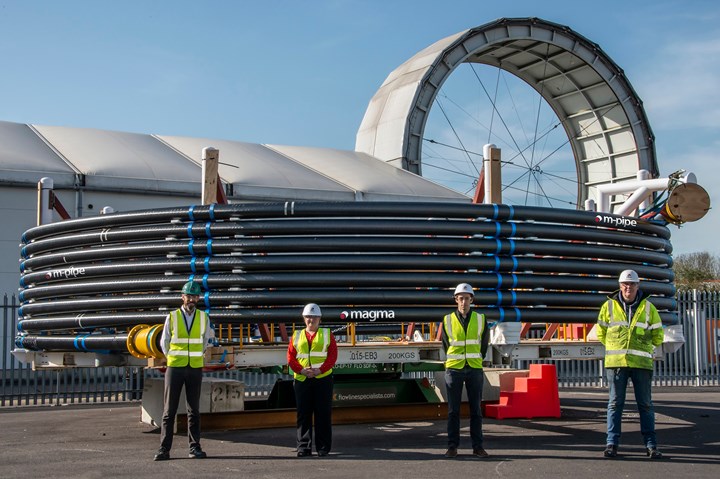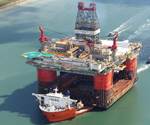Magma Global delivers high-pressure composite riser pipe to HWCG consortium
Carbon fiber-reinforced thermoplastic m-pipe designed for flexible and more rapid deepwater oil and gas emergency responses for the U.S. Gulf of Mexico.

Photo Credit: Magma Global
On May 10 Magma Global (Portsmouth, U.K.), the manufacturer of the PEEK and carbon fiber composite m-pipe, announced the delivery of what it says is the world’s first high-pressure composite riser pipe to HWCG’s (Houston, Tex., U.S.) storage location on the U.S Gulf Coast, completing its rapidly deployable Offset Flexible Riser (OFR) system.
HWCG commissioned Magma Global to qualify and manufacture a high-pressure, high-temperature m-pipe to be used as a flexible riser connection to enhance HWCG’s rapid deployment emergency well containment system. The lightweight, flexible m-pipe section will reportedly provide additional flow and capture emergency response options for HWCG’s members in the U.S. Gulf of Mexico.
HWCG is one of two deepwater oil and gas emergency response consortiums established for the U.S. Gulf of Mexico.
The m-pipe is designed for rapid installation and is suitable for responses where vertical access is restricted and an offset is required, such as shallow water depths where the presence of combustible and volatile compounds affect personnel safety, or where access under a floating production facility is needed. The system may also be used in deeper waters where more flexibility is desired in managing the marine systems during a response.
“The initial concept, and subsequent evolution, of the Offset Flexible Riser builds on the industry’s use of riser technology to manage unique operating conditions and environments requiring incident well flowback as part of a well containment strategy,” notes Andy Jefferies, deep sea development services, and OFR project manager for HWCG. “The engineering and design aspects of this breakthrough technology has been led by DSDS for HWCG. The application of the Magma m-pipe design represents a step change in that technology and brings a time-effective solution to well containment for flow and capture operations for all scenarios but is particularly well suited to shallow water, high-rate gas wells and wells requiring an offset flow and capture operation.”
Deployed straight from the handling apparatus, Magma Global says the 800-foot-long section of m-pipe will provide a flexible riser connection between the capping stack placed on the incident well and a rigid riser suspended from a MODU. The m-pipe will form a horizontally oriented “S” shape between the capping stack and the rigid pipe riser, thus decoupling motion and decreasing surface station-keeping requirements for the temporary production facility. Once in operation, hydrocarbons released from the well flow through the complete riser flow path and are processed on board the temporary production facility to be collected in shuttle tankers for transportation.
HWCG specified a pipe that would need to be compliant with movement and resistant to degradation from continuous exposure to hydrocarbons at pressures up to 10,000 psi and temperatures up to 250°F, and would offer an alternative to conventional non-bonded flexible pipe. Magma qualified the six-inch m-pipe to meet the project requirements and completed manufacture and FAT testing during the COVID-19 pandemic lock-down.
HWCG is one of two deepwater oil and gas emergency response consortiums established for the U.S. Gulf of Mexico following the Macondo blowout incident in 2010. HWCG’s response provides for the installation of a capping stack within 7-14 days and the ability to commence contingent flow and capture operations within 18 days, assuming no weather or other uncontrollable delays. Once installed, the m-pipe is qualified to operate for at least six months, which is enough time to drill a relief well to provide final well kill and containment.
“HWCG was one of the first organizations to accept the responsibility for providing equipment and personnel to respond rapidly and safely to a deepwater well incident,” says Mitch Guinn, technical director for HWCG. “The addition of a flexible riser component to our suite of response equipment further enhances our ability to respond even more efficiently by allowing more flexibility in selecting a temporary production facility and enabling the selected facility to increase its operating window regarding weather conditions. The addition of Magma’s composite m-pipe is a huge benefit for our members and is seen as one of their critical response components. We hope this work will open the doors to future applications of this breakthrough technology.”
Martin Jones, CEO at Magma Global says, “This is a bittersweet success for Magma. We are proud to supply the composite flexible riser for high-pressure, high-temperature hydrocarbons, for use in the Gulf of Mexico, yet we hope it will never have to be used. Nevertheless, m-pipe doesn’t corrode or degrade over time and hence will always be ready to enable HWCG to install at speed and with confidence.”
Related Content
Plant tour: Teijin Carbon America Inc., Greenwood, S.C., U.S.
In 2018, Teijin broke ground on a facility that is reportedly the largest capacity carbon fiber line currently in existence. The line has been fully functional for nearly two years and has plenty of room for expansion.
Read MoreThe potential for thermoplastic composite nacelles
Collins Aerospace draws on global team, decades of experience to demonstrate large, curved AFP and welded structures for the next generation of aircraft.
Read MorePlant tour: Joby Aviation, Marina, Calif., U.S.
As the advanced air mobility market begins to take shape, market leader Joby Aviation works to industrialize composites manufacturing for its first-generation, composites-intensive, all-electric air taxi.
Read MoreThe lessons behind OceanGate
Carbon fiber composites faced much criticism in the wake of the OceanGate submersible accident. CW’s publisher Jeff Sloan explains that it’s not that simple.
Read MoreRead Next
Oil & gas: Will the composite riser rise again?
A new effort to develop a undersea pipe resets the long-term development course, again, toward an all-composite design for deepwater-capable oil and gas risers.
Read More“Structured air” TPS safeguards composite structures
Powered by an 85% air/15% pure polyimide aerogel, Blueshift’s novel material system protects structures during transient thermal events from -200°C to beyond 2400°C for rockets, battery boxes and more.
Read MoreVIDEO: High-volume processing for fiberglass components
Cannon Ergos, a company specializing in high-ton presses and equipment for composites fabrication and plastics processing, displayed automotive and industrial components at CAMX 2024.
Read More


























